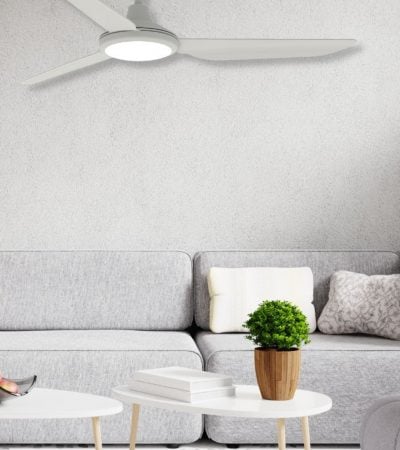
Shop the best price on ceiling fans with our lowest fan price guarantee!
Shop the best price on ceiling fans with our lowest fan price guarantee!
To NSW, ACT & VIC, and metro QLD & SA*
If you find a lower price, we’ll match it!
Sign up for exclusive VIP discounts all year round!
On an average, you inhale approximately 14,200 litres of air and drink around 2 litres of water per day. You certainly understand the health benefits of drinking clean water, yet, most people do not realise or are ignorant of the importance of clean and pure air to breathe. At home, at school, at office or at a club or a restaurant, you spend 90% of our time indoors. Given this simple fact, it is of utmost importance that the air you breathe in has to be clean and pure indoors too. The pollution is not causing harm to us only when you are outside but indoors too. In warm weather, pollen count goes up to 800% (8 times higher) and finds way inside your home easily. Poor indoor air quality is among the top 5 health risks and is directly associated with diseases like asthma, allergies, fatigue, dry eyes, nausea and even lung cancer!
The children, elderly and pregnant women are most prone to the effects of poor air quality indoors.

The bad quality of indoor air can be caused by a myriad of factors. These can be classified into activities related to combustion and those which are not. Combustion-related activities adversely affect the quality of indoor air by releasing particles and gasses as a result of a chemical process. Non-combustion related activities, on the other hand, are those activities which affect the indoor air quality without the chemical process.
Combustion-related activities generally release particles and gasses as a by-product of combustion. These involve some sort of fire or heat-encouraged activity. Common issues that may arise from these activities are smoke, an increase in the level of dangerous gasses, and an increase in temperature – all of which could contribute to a decrease in the quality of indoor air.
Some combustion-related activities are listed below:
Smoking releases a number of substances into the environment which can adversely affect human health due to their toxic composition. Cigarettes also emit foul-smelling smoke and other chemicals including carbon monoxide and formaldehyde. They also release particulate matter and volatile organic chemicals (VOCs). The resulting effect is that the due to the chemicals released by smoking into the environment, second hand smokers are as likely to be adversely affected as the smokers themselves.
Heating, or burning materials to produce heat, also produces a wide range of substances which can negatively affect the quality of air. Like smoking, heaters such as fireplaces, furnaces, can emit carbon monoxide, nitrogen dioxide, VOCs, and particulate matter.
Garage activities usually involve the activities related to vehicles, and the indoor of use of machines and appliances, like lawnmowers and snow blowers, which also emit pollutants and dangerous substances.
Cooking also produces pollutants and substances which, in large doses, can affect us negatively. Some cooking methods like frying emit more substances than others, and cooking using gas without a range hood can also contribute to deteriorating air quality. Usual suspects caused by cooking are particulate matter and nitrogen dioxide.
At first glance, it may seem improbable for these activities to contribute to deteriorating indoor air quality, but because of their composition and use, they actually also release substances to the environment, albeit not as much and not as dramatic as combustion activities. Among these are the following:
Common household items can release pollutants and substances through a process called off-gassing. Carpets, furniture, candles, air fresheners and cleaning products can release VOCs at a low rate. Upholsteries like carpets, pillows, and foams also attract mites and other insects which can release allergens into the environment.
Using products such as perfumes and cosmetics releases chemicals as well due to their composition.
Materials used in construction can also be a source of pollutants and VOCs. Among the usual suspects are insulation, wood products, floor panels, paints, solvents, and varnishes.
Hobbies such as woodworking, carving, painting, and other crafts can also be a source of pollutants because of the materials used in these activities.
Areas where there is stagnant concentration of water can be a place for biological pollutants like bacteria and fungi to grow. Humidity can also contribute to the growth of these organisms
Factors such as the amount of fresh air in the building and the rate which contaminated air is expelled contribute to indoor air quality. Keeping the levels of ventilation inside the building is a sure way to decrease the quality of air inside.

Bad indoor air quality can cause a myriad of adverse effects to those exposed to it. This can cause not only physical problems to those who have inhaled it, but psychological ones as well. If left unchecked, the consequences caused by bad indoor air quality can be severe. Here are some of these effects:
It is important to keep the level of indoor air quality at high levels in the face of these consequences. Luckily, there are easy steps which can be done to help keep the levels of indoor air quality in suitable conditions.
It is important to keep your place properly ventilated. This ensures that contaminated air is taken out and regularly replaced with clean and fresh air.
Fluctuating temperatures can cause the growth of several biological pollutants. Keeping your temperatures constantly at the proper levels can keep the levels of these pollutants checked.
It is also important to clean the affected areas to ensure that conditions which could contribute to poor indoor air quality would not arise.
Whenever possible, activities like smoking and open-air barbecue should be done in outdoor spaces to avoid the accumulation of pollutants and particles inside.
Do not ignore indoor air quality problems and take steps today to improve it. If you have struggled with indoor air quality and want to improve it but not sure from where to begin, call in a ventilation expert who can help you in this. Act now for clean air and a better life!
Check out the Tastic Vivid 3 in 1 Bathroom heater fan and light. With its improved airflow, the Tastic Vivid’s exhaust fan effortlessly removes steam from your bathroom environment, while the two 275W powerful heat lamps warm you when the chill sets in.
The Tastic Vivid 3 in 1 features a multi-option LED light globe, allowing you to interchange between Warm, Cool and Daylight illumination at the flick of a switch to customise the light setting to your preference.
Become a Rovert VIP to unlock exclusive savings & offers!
Shop VIP prices
PLUS save $10 on your first
online order over $100!
